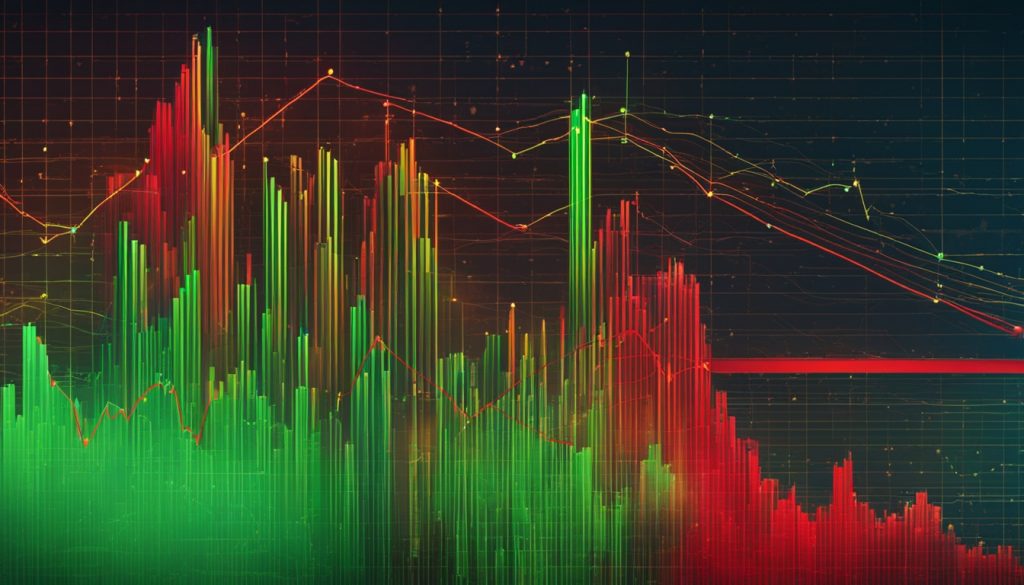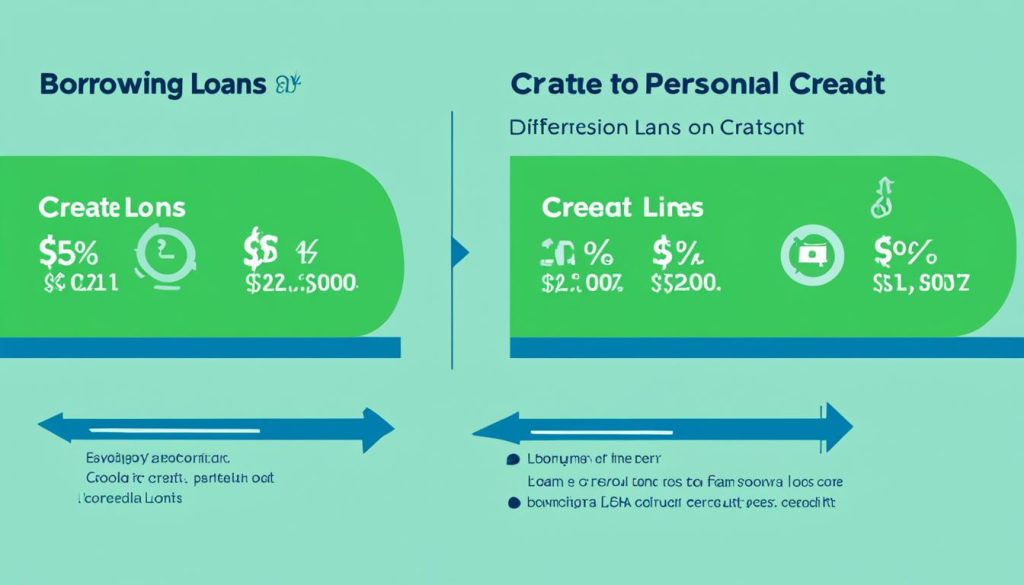When you need to borrow money, you have many options. You can choose between personal lines of credit and personal loans. Each has its own benefits, but knowing the differences helps you pick the right one for your needs123.
Personal loans give you a big sum of money that you pay back over time. The interest rates can be between 4% to 36% APR23. Personal lines of credit, however, let you borrow money as you need it. They have variable interest rates, usually starting around 10% APR23.
To get a personal loan, you usually need a credit score of about 580. For a personal line of credit, you’ll need a score of at least 67023.
Key Takeaways
- Personal loans provide a lump-sum of money with fixed monthly payments, while personal lines of credit offer ongoing access to funds with variable interest rates.
- Personal loans typically have a lower minimum credit score requirement than personal lines of credit.
- Personal loans have fixed interest rates, while personal lines of credit have variable rates.
- Personal loans have term lengths between 2-7 years, while personal lines of credit have a draw period and a repayment period.
- Both personal loans and lines of credit do not require collateral, but interest rates may be higher due to the lack of collateral.
Understanding Personal Loans
A personal loan is a type of loan where you borrow a set amount of money. You pay it back in regular monthly payments over a certain time, usually 1-7 years4. These loans are great for big expenses like weddings, home improvements, or paying off debt. They give you a lump sum upfront and have fixed interest rates4.
What is a Personal Loan?
Personal loans have fixed interest rates. The average APR for a two-year loan is 9.58%, says the Federal Reserve4. Unlike personal lines of credit, which have changing rates, personal loans have fixed ones. Rates for personal lines of credit range from 9.30% to 17.55%, with some as low as 2.25%4.
Advantages and Disadvantages of Personal Loans
One big plus of personal loans is knowing your monthly payments. But, they often have higher interest rates than other options, like credit cards, which average 16.30%4. Once you get a personal loan, you can’t borrow more money, unlike with personal lines of credit4.
It’s key to have a plan to pay off personal loans. Know the interest rates and how you’ll repay them to manage your monthly payments4. Some lenders add fees to personal loans, while personal lines of credit might have yearly and withdrawal fees5.
Personal loans can help with one-time costs or consolidating debt. But, think carefully about the good and bad before choosing this loan type for your situation456.
“Always make sure to have a plan to pay off personal loans or personal lines of credit and understand the interest rates and repayment terms.”
Exploring Personal Lines of Credit
Personal lines of credit are a flexible way to borrow money. They don’t give you a lump sum like personal loans do. Instead, you can use funds as needed up to a set limit7. This makes them great for handling variable or unexpected costs, like home improvements, medical bills, or emergencies7.
What is a Personal Line of Credit?
A personal line of credit is a revolving credit type that lets you tap into a fund pool as needed8. Unlike personal loans, you don’t get the full amount upfront. You can borrow only what you need, when you need it8. This is handy for ongoing costs or sudden financial emergencies7.
Benefits and Drawbacks of Personal Lines of Credit
They have lower interest rates than credit cards, making them a good choice7. You can also get to your money fast during the draw period7. But, they come with some downsides, like variable interest rates that can make budgeting hard7. You also can’t deduct the interest on your taxes7.
To get a personal line of credit, you usually need good or excellent credit. Lenders will check your credit hard7. These lines of credit are unsecured, meaning you don’t need collateral. But, this can make them harder to get if your credit is poor7.
| Benefits of Personal Lines of Credit | Drawbacks of Personal Lines of Credit |
|---|---|

When thinking about a personal line of credit, consider the pros and cons to see if it fits your financial needs and situation78.
personal lines of credit, personal loans, borrowing options
When looking at personal financing, you have two main choices: personal loans and personal lines of credit. Both are unsecured forms of borrowing, meaning they don’t need collateral like a home or car9. The main difference is in how flexible and structured the financing is.
Personal Loans give you a big sum of money, usually between $1,000 and $50,000, with fixed interest rates and set repayment times9. This means you know what your monthly payments will be and when you’ll pay off the debt10. On the other hand, Personal Lines of Credit let you use money as you need it, up to a certain limit, with changing interest rates11.
Choosing between a personal loan or a personal line of credit depends on your financial needs and how you spend money. Personal loans are good for one-time costs, like paying off debt or fixing up your home, while personal lines of credit are better for ongoing or changing expenses10.
| Feature | Personal Loan | Personal Line of Credit |
|---|---|---|
| Borrowing Limit | $1,000 to $50,0009 | Up to $25,0009 |
| Interest Rate | Fixed APR11 | Variable APR11 |
| Funding Structure | Lump sum11 | Revolving access11 |
| Collateral | No collateral required11 | No collateral required11 |
The best borrowing option for you will depend on your financial situation and goals. By knowing the main features of personal loans and lines of credit, you can choose the right one for you10.

“Careful consideration of your borrowing needs and financial profile can help you determine the most suitable option between personal loans and personal lines of credit.”
Comparing Personal Loans and Lines of Credit
Personal loans and lines of credit are two common ways to borrow money. They have different features that can affect your financial situation. Knowing these differences can help you pick the best option for you.
Key Similarities
Both personal loans and lines of credit don’t need collateral. To get them, you need to show you can pay back the money. This means your credit score, income, and how much debt you have compared to your income matter a lot12.
Key Differences
Personal loans give you a set amount of money all at once. You’ll have a fixed interest rate and a set time to pay it back, usually 12 to 60 months13. Lines of credit, on the other hand, let you borrow money as you need it. The interest rates can change, and you only pay back what you borrow12.
Personal loans can be from $1,000 to $50,00012. Lines of credit usually don’t go over $20,00012. You can get personal loans from banks and credit unions12. But, you can also get lines of credit online, which makes getting credit easier12.
Lines of credit are good if you have expenses that change or are unexpected. But, the monthly payments can change, making budgeting hard. Loans are better for big purchases you know about ahead of time. They have fixed payments12. Lines of credit are good for when you’re not sure how much you’ll need13.
“Personal loans are generally better for one-time major expenses with a known total cost and can help improve credit scores through timely payments, while personal lines of credit are better suited for variable, ongoing, or unpredictable expenses and emergencies, providing a financial safety net.”13
When to Choose a Personal Loan
Personal loans can be a great choice for certain situations. They work well for big, one-time expenses like fixing up your home or paying off debt8. These loans have fixed repayment plans and interest rates, making budgeting easier8. Paying back a personal loan on time can also help improve your credit score14.
With personal loans, you get the money all at once and pay it back in set monthly payments8. This is perfect for big, one-time costs like a home makeover or a big buy8. Unlike personal lines of credit, they don’t offer the same flexibility but are great for planned expenses8.
Personal loans usually have lower interest rates than credit cards, making them cheaper for consolidating debt14. Their fixed repayment plans help you stay disciplined and avoid revolving debt8.
For ongoing or variable costs, personal lines of credit might be better. But for specific, one-time expenses with a known cost, personal loans are the way to go8. Think about your financial goals and what you need to finance to decide between a personal loan or a line of credit148.
Conclusion
Personal loans and personal lines of credit are both flexible ways to borrow money. But they are best for different financial needs. If you have a one-time expense in mind and know the exact amount, a personal loan might be right for you15. This type of loan has fixed terms and payments.
But if you think you’ll have ongoing or variable expenses, a personal line of credit could be better15. This option lets you borrow money as you need it.
When looking at your borrowing options, think about your credit score, debt-to-income ratio, and how you plan to use the money15. Secured lines of credit need collateral, while unsecured ones don’t. Also, personal loans from places like U.S. Bank have good rates and terms9. Eligible checking clients can borrow up to $50,000.
The choice between a personal loan and a line of credit depends on your financial situation and spending habits15. Look at your needs, check out the options, and pick the one that fits your financial goals best.
FAQ
What is the difference between a personal loan and a personal line of credit?
Personal loans and lines of credit are both financial tools. But they work in different ways. Loans give you a set amount of money to borrow with fixed payments. Lines of credit let you borrow money as you need it, with changing interest rates.
What are the key features of a personal loan?
Personal loans are installment loans without collateral. You get a set amount of money upfront. Then, you pay it back in monthly installments over a few years, usually 1-7 years. They’re great for big, one-time costs like weddings, home fixes, or paying off debt. They offer a fixed interest rate.
What are the benefits and drawbacks of personal loans?
Personal loans have fixed interest rates and repayment plans, making budgeting easier. But, they might have higher interest rates than other loans. Also, you can’t borrow more once you’ve used up the loan amount.
What is a personal line of credit?
A personal line of credit lets you borrow money as you need it, up to a set limit. It’s different from a loan because you don’t get a lump sum upfront. You can use the funds during the draw period and only pay interest on what you use.
What are the advantages and disadvantages of personal lines of credit?
Personal lines of credit are great for unexpected or variable costs, like home repairs or medical bills. But, they have variable interest rates. This can make planning your budget harder.
When is a personal loan the better choice?
Choose personal loans for big, one-time expenses with known costs, like fixing up your home or consolidating debt. Their fixed terms and rates make budgeting simpler.
When is a personal line of credit the better choice?
Go for a personal line of credit if you think you’ll have ongoing or unpredictable expenses. It offers the flexibility to borrow as needed. The variable rates and ongoing access to funds suit those with changing financial needs.
Source Links
- Comparing Personal Loans and Lines of Credit
- Personal Line Of Credit Vs. Personal Loan | Quicken Loans
- Personal Loan Vs. Line Of Credit: Which Is Better For Your Wallet?
- Personal loan vs. personal line of credit: What’s the difference?
- Personal Loans vs. Personal Lines of Credit: Learn the Difference – NerdWallet
- Personal Line of Credit vs. Personal Loan: Key Differences
- What Is A Personal Line Of Credit And How Does It Work? | Bankrate
- Personal Loan vs. Personal Line of Credit
- Personal loans & lines of credit at U.S. Bank
- Personal Line of Credit vs. Personal Loan
- Personal Loans from PNC Bank: Compare Rates & Apply Online
- Personal Loans vs. Personal Lines of Credit | Bankrate
- Personal Loans vs. Personal Lines of Credit: What’s the Difference? (2024 Guide)
- Loan vs. Line of Credit: What’s the Difference?
- What is a Personal Line of Credit?

